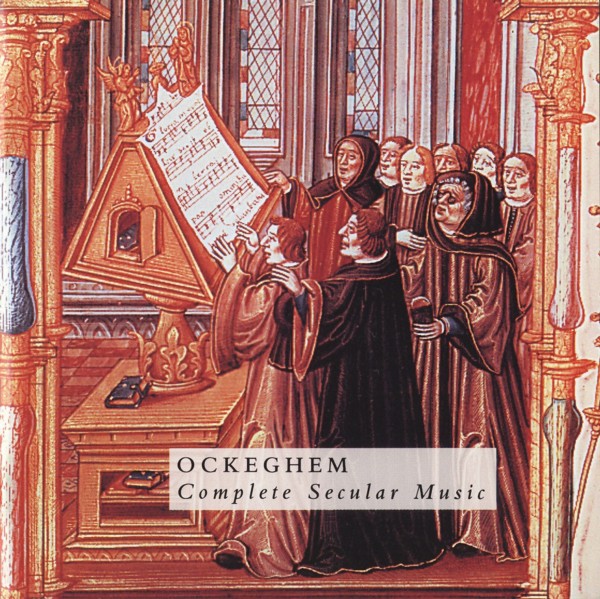
"This is a very fine project, one of the best 15th century song collections made to date."
medieval.org - L'Oiseau-Lyre DL 254 D3 (LPs)
medieval.org - L'Oiseau Lyre 436 194 (CDs)
febrero de 1981 (CDs: 1993)
St George the Martyr, London
CD1
01 - Ma bouche rit (MPh, GS, fiddle) [5:13]
02 - La despourveue (RCC, harp, gittern) [6:03]
03 - D'un autre amer (MPh, 2 fiddles) [4:31]
04 - Quant ce viendre (TP, RCC, gittern) [5:28]
05 - Il ne m'en chault plus (TP, RCC, fiddle) [3:54]
06 - Presque trainsi (RCC, harp, gittern) [5:55]
07 - Ma maistresse (TP, 2 fiddles) [5:04]
08 - Les desleaux (RCC, GS, harp) [4:42]
09 - Mort tu as navre (TP, RCC, GS, MG) [7:15]
10 - Quant de vous (RCC, douçaine, lute) [5:03]
11 - Au travail suis (MPh, GS, fiddle) [4:51]
12 - Prenez sur moi (TP, shawm, gittern) [5:11]
CD2
01 - Fors seulement l'actente (TP, RCC, lute) [7:09]
02 - L'autre d'antan (MPh, GS, fiddle) [2:40]
03 - S'elle m'amera (TP, RCC, GS, MG) [4:29]
04 - O rosa bella (RCC, lute) [3:30]
05 - Tant fuz gentement (MPh, 2 fiddles) [4:23]
06 - Je n'ay dueil (TP, RCC, lute) [5:14]
07 - Malheur me bat (harp, dulcimer, lute) [2:11]
08 - Se vostre cuer (2 shawm, sackbut) [1:21]
09 - Johannes CORNAGO - Qu'es mi vida (3 recorders) [2:29]
10 - CORNAGO-OCKEGHEM - Qu'es mi vida (TP, douçaine, fiddle, gittern) [3:07]
11 - Je n'ay dueil (rebec, dulcimer, douçaine, lute) [1:50]
12 - Ce n'est pas jeu (TP, RCC, GS) [6:53]
13 - Resjois toy (TP, RCC, GS, MG) [2:56]
14 - Departez vous (flute, fiddle, lute) [1:18]
15 - Ung aultre l'a (TP, RCC, fiddle) [4:22]
16 - Autre Venus (MPh, 2 fiddles) [4:27]
17 - Baissiez mois (recorder, rebec, guittern) [1:34]
18 - Fors seulement contre ce (TP, RCC, MG) [7:41]
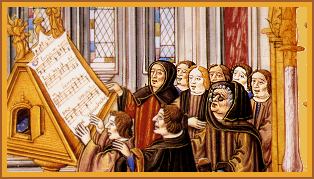
THE MEDIEVAL ENSEMBLE OF LONDON
Peter & Timothy Davies
Margaret Philpot, alto - CD1 #1, 3, 11; CD2 #2, 5, 16
Timothy Penrose, countertenor - CD1 #4-5, 7, 9, 12; CD2 #1, 3, 6, 10, 12-13, 15, 18
Rogers Covey-Crump, tenor - CD1 #2, 4-6, 8-10; CD2 #1, 3-4, 6, 12-13, 15, 18
Geoffrey Shaw, baritone - CD1 #1, 8-9, 11; CD2 #2-3, 12-13
Michael George, baritone - CD1 #9; CD2 #3, 13, 18
Peter Davies
recorder: CD2 #9, 17 - flute: CD2 #14
douçaine: CD1 #10; CD2 #10-11
alto shawm: CD1 #12; CD2 #8
harp: CD1 #2, 6, 8; CD2 #7
Andrew Watts - soprano shawm: CD2 #8 - recorder: CD2 #9
Martin Pope - sackbut: CD2 #8 - recorder: CD2 #9
Timothy Davies
gittern: CD1 #2, 4, 6, 12; CD2 #10, 17
lute: CD1 #10; CD2 #1, 4, 6-7, 11, 14
Gregory Knowles, dulcimer: CD2 #7, 11
Robert Cooper
fiddle: CD1 #1, 3, 7, 11; CD2 #2, 5, 14, 16
rebec: CD2 #11, 17
William Hunt, fiddle - CD1 #3, 5, 7; CD2 #5, 10, 15-16
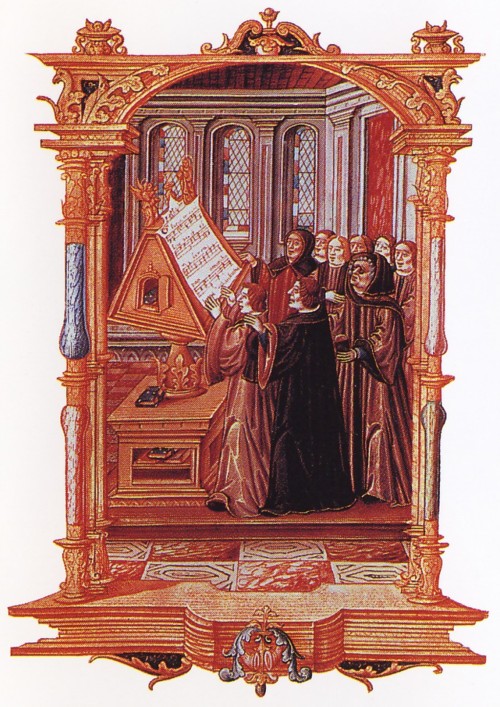
JOHANNES OCKEGHEM
COMPLETE SECULAR
MUSIC
For his 'subtle songs, artful masses and harmonious motets', as well as
for his prowess as a singer, Johannes Ockeghem was accorded by his
contemporaries first place among musicians of the mid-fifteenth
century, a view fully endorsed by present-day commentators.
The exact date of his birth is unknown, but the most recent suggestion
puts it about 1410, at least a decade earlier than previous estimates.
Even more uncertain is his place of origin: Hainault and Dendermonde in
East Flanders have been proposed. The family itself may originally have
come from Okegem, a village about fifteen miles east of Brussels.
The earliest documentary references to Johannes Ockeghem date from the
1440s. Between 1443 and 1444 he was listed as a singer at Notre Dame in
Antwerp, and by 1446 he had joined the chapel of Charles I, Duke of
Bourbon. Shortly after this he became attached to the French court, and
spent some forty-six years, until his death in 1497, serving three
successive kings: Charles VII, Louis XI and Charles VIII. He quickly
rose to a pre-eminent position within the French Chapel. By 1454 he was
premier chapelain, and five years later was highly honoured by
being appointed treasurer of the wealthy Abbey of St Martin de Tours.
In 1470 he took part in a diplomatic mission to Spain during which he
apparently found time to make an arrangement of Cornago's Qu'es mi
vida preguntays.
Ockeghem was not a prolific composer - apart from the secular music we
have only eleven complete Masses, a Requiem and nine motets - but it is
the quality of these few works which has impressed audiences both of
his time and our own. His fame today is based primarily on the Masses,
but some of his secular songs must have been amongst the most popular
works of their kind in the later fifteenth century to judge from the
number of manuscripts in which they are preserved. They also present a
different side of the composer's art; Ockeghem not only executed some
of the grandest designs in the whole repertoire of fifteenth-century
sacred music but also handled the traditional and stylised forms with
delicacy, imagination and variety.
This recording presents all the chansons attributed to Ockeghem in
fifteenth-century manuscripts. Included are twenty chansons and two
arrangements definitely by Ockeghem, and five chansons variously
attributed to Ockeghem and to other composers in different sources - Au
travail suis (also attributed to Barbingant), Departez vous
(Guillaume Dufay), Ce re'estpas jeu (Hayne von Ghizeghem), Quant
ce viendra (Antoine Busnois) and Malheur me bat (Martini or
Malcort). Opinions differ as to which of these are more likely to be by
Ockeghem, but generally the ascriptions to him seem more plausible in
the case of the first two. Many fifteenth-century chansons, whether
appearing in a single manuscript or several, carry no attribution
whatever. It may be that some of these anonymous works are Ockeghem's,
and over the years a few possibilities have been advanced. As an
example we have included Resjois toy tern de France.
André Pirro has pointed out that this piece was probably written
for the accession of Louis XI in 1461, and David Fallows has suggested
that the composition may thus be by Ockeghem, the master of the royal
chapel of the time, particularly in view of the comparable style and
layout of his four-part Mort to as navre de ton dart of 1460-61.
The majority of the secular texts that Ockeghem chose to set to music
express the traditional formulae of courtly love. In them we may find a
lover extolling the beauty of his lady (as in Autre Venus ester),
affirming his loyalty to her (D'un autre amer), expressing the
pain that love causes him (Je n'ay dueil), which is only made
worse when he cannot see his lady (Quant de vous seul) or feels
her indifference (Fors settlement l'actente), and which leaves
him close to death (Presque trainsi). He complains of disloyalty
(Ma bouche rit) but occasionally can relate the joys of
fulfilment (Tant fuz gentement resjouy), and will sometimes
offer advice (Prenez stir moi).
Such recurring themes are expressed with conventionalised language
(emphasizing key words such as dueil, maleur, confort and plaisir)
in rigid lyric forms. Reconciling these factors whilst achieving subtle
variation of content posed not inconsiderable technical difficulties,
and it was by solving these with elegance, artifice and invention that
the poet hoped to delight his listeners; a poem such as L'autre
d'antan, with its markedly different language and content, is a
comparative rarity.
The rondeau, the bergerette and the ballade
were the standard lyric forms of the fifteenth century, and Ockeghem's
secular works present examples of all three. Most popular of these formes
fixes was the rondeau; this is reflected in its use for eighteen
out of the twenty-six vocal items on these records. The form of the
rondeau results from the alternation of a recurring group of lines, the
refrain (R), with lines presenting new material, the stanzas
(S), in the pattern RS RSR. The refrain itself generally has either
four lines (in a rondeau quatrain) or five (in a rondeau
cinquain), presenting the rhymes to be used (always two, referred
to as a and b) and the rhyme scheme (abba or aabba).
The rhyme scheme is divided into two distinctive units (ab and ba
in a quatrain, aab and ba in a cinquain) which are used
throughout the poem. These two units of rhyme may be designated A and B.
The music for a rondeau is essentially a setting of the refrain. The
composer provides a musical phrase for each refrain line, and ensures
that the resulting composition falls into two sections which correspond
to the two units of rhyme and which can also be designated A and B.
Since the same rhymes A and B occur throughout the poem, the lines in
which they occur can simply be set to the relevant sections of music.
The first stanza and second statement of the refrain are short - that
is to say use only rhyme A - and both are set to music A. These two
portions of the poem are linked to form a unit comparable in size to
the full stanza and refrain, as can be seen in the layout of the
printed rondeau texts in the booklet. The second stanza, like the
refrain, uses rhymes A and B and is consequently set to both musical
sections. Using capitals for the refrain and lower case for stanzas,
the overall musical and poetic form can be represented as AB aA ab AB.
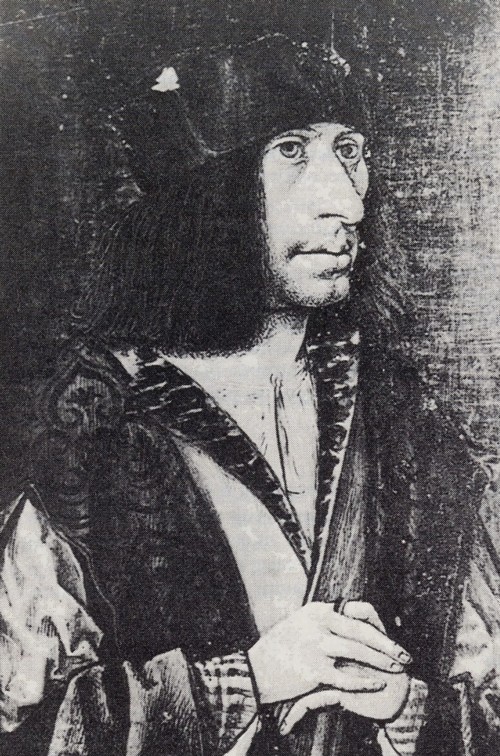
The bergerette, a shortened version of the fourteenth-century virelai,
became popular after the middle of the fifteenth century and is used in
four of Ockeghem's songs. The bergerette is quite similar in form to
the rondeau; it opens and closes with a refrain, usually of five lines
rhyming aabba, and includes a stanza of identical structure.
Refrain and stanza are sung to the same music (A). The characteristic
of a bergerette, however, is the presence of two short stanzas which
introduce a different rhyme (usually ccd) and which are
therefore provided with a separate section of music (b). The resulting
form is A bb a A.
In a motet-chanson the French poem is amplified and commented on by a
Latin text set to one or more of the lower voices. The Latin text and
its melody always use preexisting material. In Mort tu as navre
text and music quote the final verse of the Dies irae; in Resjois
toy terre de France they draw on the first Antiphon for Christmas
Day Vespers.
The motet-chanson has no fixed form. Dufay's Lamentation on the
Fall of Constantinople, for example, is through-composed, whilst
later examples by Alexander Agricola and Loyset Compère are
based on the rondeau and bergerette. The two works included here,
however, use the ballade form. The ballade was the most common
of the formes fixes in the fourteenth century, but gradually
lost popularity, except in England, as a medium for courtly love songs.
By Ockeghem's day it was mostly used in secular works written for
specific occasions: to celebrate the accession of a king (as in Resjois
toy terre de France) or lament the death of a famous musician (as
in Mort tu as navre). Ballades should properly have three
structurally identical stanzas, but for many compositions only one of
these has been preserved. Such pieces can nevertheless be performed
quite satisfactorily since each stanza expresses the characteristic
ballade form (a a b) by itself. Where three stanzas exist the final
line is common to each and acts as a refrain.
The rondeau S'elle m'amera is also a bitextual work but of a
very different character. It belongs to a quite large repertoire of
later-fifteenth-century chansons, including works by Antoine Busnois
and Robert Morton, in which the highly wrought melody and courtly text
in the upper voice are combined with the lighthearted words and music
of a popular song set in one or more of the lower parts.
The Spanish canción form, used in Qu'es mi vida
preguntays, is similar to a bergerette except that there is
apparently no final statement of the refrain, which instead is worked
into the preceding stanza to give the form A bb a. For details of the ballata,
see the 'Note on the performances' below.
For the greater part of the fifteenth century a musical texture
composed of three voices was customary for secular works and is used by
Ockeghem for all but two of his original songs. Each of the voices has
a different and clearly defined function. The highest voice (or cantus)
carries the principal melody of a composition and is combined with a
lower voice (or tenor) in such a way that the two form a
harmonically self-sufficient unit. To this is added a third voice (or contratenor)
to enrich the harmony, without being essential to it, and to help
control the flow of the music.
The importance of the cantus-tenor duet is sometimes emphasised by
imitation between the two voices. This technique is employed in a
variety of ways by Ockeghem, ranging from its formal use at the
beginning of Baissiez moi dont fort to its fleeting appearance
in the middle of a phrase of Autre Venus estes. From some songs
it is entirely absent, or almost entirely (for example La
despourveue, Presque trainsi and Se vostre ater), in others
it appears in two or three places, in particular at the opening of the
second musical section (for example D'un autre amer, Il ne m'en
chault plus, Les desleaux and Ma bouche rit); occasionally
it is used throughout, as in Je n'ay dueil and Ung altre l'a.
Ockeghem's treatment of the contratenor in this type of song is
characterised by extreme elegance and clarity. Whilst occupying much
the same range as the tenor, the contratenor tends to move consistently
above or below it within each phrase, avoiding the constant crossing
and recrossing typical of earlier chansons. This approach is used in
the rondeaux D'un autre amer, Autre Venus estes, Les desleaux, La
despourveue, L'autre d'antan and Quant de vous seul, and
results from the strongly melodic nature of Ockeghem's contratenors. To
develop this feature more freely the contratenor is sometimes given a
discrete register in which to operate. The contratenors of Baissiez
nioi dont fort, Je n'ay clued, Se vostre cuer, Fors seulement contre
ce, Ung aultre l'a and Il ne ni'en chault plus all move
almost exclusively below the tenor, and in the case of the last two
works this allows for some particularly florid writing.
Some of the three-part works use rather different textures. Prenez
stir moi is a strict canon at the fourth and also a catholicon
- a work which may be performed in a number of different modes. This
fine piece, no less beautiful than 'scientific', is of course untypical
of Ockeghem's chansons as a whole, but became a standard textbook
example for sixteenth-century theorists who would have had no interest
in his other secular works. Of more immediate influence was Fors
seulement l'actente. Like Dufay's La plus mignone de mon cuer
it has two cantus of similar range related by frequent imitations and
supported by a lower voice labelled concordans. Ockeghem used
the cantus I of Fors seulement l'actente as the lowest voice of
Fors seulement contre ce, adding a new tenor and cantus, and in
the later fifteenth century one or other of the parts was used by
composers such as Jacob Obrecht, Antoine Brumel and Pierre de La Rue as
the basis for similar reworkings.
During the second half of the fifteenth century four-part writing
became increasingly popular in secular music, and many favourite
three-part works had a second, optional contratenor added to bring them
into line with fashion. Ockeghem went further than this when he
arranged Qu'es mi vida preguntays, discarding Cornago's
contratenor and adding to the original cantus and tenor two new
contratenors of his own. Similar procedures may account for the
differing versions of [/i]Je n'ay dueil (see 'Note on the
performances'). Mort tu as navre and S'elle m'amera,
however, were conceived as four-part works. To emphasise this the tenor
and two contratenors begin both sections in the first of these works,
while in the second the lower three voices achieve near-equality in
their imitative presentation of the popular song Petite Camusette.
As mentioned above, Ockeghem adopts a traditional approach to setting
the texts of his songs, giving each line a separate melodic phrase. He
shows a liking for syllabic declamation on repeated notes (for example
in Ung aultre l'a, Autre Venus estes, La despourveue and Tant
fuz gentement resjouy) and the use of a dactylic rhythm to open
phrases (prominent in at least eight songs), but this often leads to
lines of extraordinary convolution (as in Les desleaux).
Ockeghem uses various devices to ensure clear progression through a
song. Like Dufay he employs a carefully planned series of cadences on
important degrees of the scale, but regularly suppresses one or more of
them in the interests of forward movement (as at the beginning of Autre
Venus estes, D'un autre amer, Il ne m'en chault plus and La
despourveue). In addition, Ockeghem's arched phrases, like Dufay's,
are given a greater sense of purpose by exploiting different registers
within the overall melodic compass. In the rondeau Il ne m'en
chault plus, for example, the five phrases use a total compass of a
twelfth (g-d"). The first two phrases concentrate on the upper part of
this range (d'-c") while the third introduces the lower notes (a-b').
The next phrase - the first of the second section explores the middle
register (d'-a'), but it is only after this that the full compass is
introduced, in a magnificent concluding phrase which moves quickly from
c' to low g, climbing a full octave-and-a-half to the top d" before
falling to the final g'.
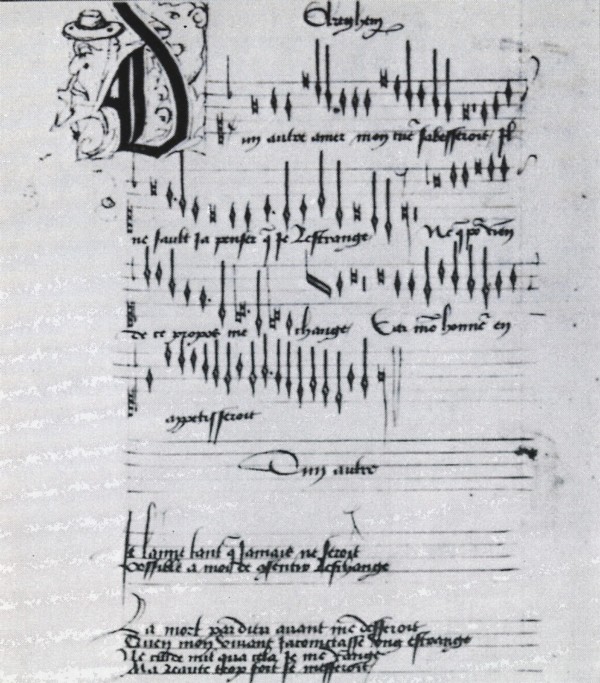
ARRANGEMENT OF THE ITEMS
Only two of Ockeghem's secular works can be dated. Mort tu as navre
must have been written soon after Binchois's death in 1460, and the
arrangement of Cornago's Qu'es mi vida preguntays was
presumably carried out during the composer's visit to Spain in 1470. In
the absence of any further chronology, it seemed best to arrange the
works on these discs according to the dating of the manuscripts in
which they are preserved. The sources used fall into the following
groups:
I. Manuscripts of French or Burgundian provenance, 1460-1480: Lab.,
Dij. 517 and Niv., also Trent 90, an Italian MS
compiled during the same period.
II. Italian manuscripts, 1480-1500: Cas. 2856 (Ferrara, started
1480), Mc 871 (Naples, 1480s), Pix. (Florence, c.1485),
Bol. Q17 (Florence, c.1494).
III. French manuscripts, 1480-1500: Lab. II (c.1485), Ricc.
2794 (before 1488), Paris 1596 (c.1495).
IV. Bass., an early-sixteenth-century manuscript. compiled in
the Netherlands.
The items are arranged as follows:
CD1 #1-8 Lab.
CD1 #9-12, CD2 #1-3 Dij. 517
CD2 #4 Trent 90; #5 Niv.; #6
Bol. Q17
#7-8 Cas. 2856; #9-10 Mc 871;
#11-12 Lab. II
#13-14 Pix.; #15-16 Ricc. 2794;
#17 Bass.; #18 Paris 1596.
NOTE ON THE PERFORMANCES
All the works on these records were transcribed from the sources listed
above, except in the case of the two items from Mc 871, where the
printed edition of the manuscript was used. Many of the songs have been
made available over the years in various publications. These are listed
by Perkins, together with the manuscript concordances.
Only items with fully preserved texts were sung; the rest were
performed instrumentally. In most sources works appear with text
underlayed for the cantus only, but in many cases it seemed appropriate
to text the tenor as well, particularly when this was more than usually
imitative. The underlay of Fors seulement 1'actente, which
because of the unusual relationship of the two cantus presents a rather
tricky case, follows the underlay given in Paris 1596.
The text of O rosa bella is a ballata (an Italian lyric form
similar to the bergerette) but the music does not allow it to be
performed as such. We have adopted David Fallow's suggestion (in his
note to the performance of Bedyngham's original three-part work on
L'Oiseau-Lyre D186D4) that 'the composer, misunderstanding the form of
the original poem, intended it to be a song of two simple stanzas'.
This applies equally to Ockeghem's arrangement, which consists of
Bedyngham's melody with an additional second cantus.
Je n'ay dueil is known in two four-part versions, but as Martin
Picker has pointed out, neither is likely to be original. We have
included an instrumental performance of the more common of these
(presumed) arrangements (CD2 #11), as well as a vocal performance of
what may well be the authentic three-part work (CD2 #6]) (see Picker
pp.61-2 and 121). This is the version in Bol. Q17 without the
rather busy second contratenor which has all the appearances of a later
addition. Performed in this three-part way, the striking quality of the
cantus and tenor combination, with its duet passages and frequent
imitations (not unlike Fors seulement l'actente), is revealed.
ACKNOWLEDGEMENTS
Grateful thanks are due to three people for their generous and
invaluable help in the preparations for this recording: David Fallows,
who loaned several microfilms and discussed many points; Warwick
Edwards, who made both text readings and microfilms available; and
Brian Jeffery, for his elucidation of some difficult texts.
Peter Davies
BIBLIOGRAPHY
Leeman Perkins: 'Ockeghem', The New Grove (1980)
Martin Picker: The Chanson Albums of Marguerite of Austria
(Berkeley, 1965)
Howard Mayer Brown: 'Instruments and Voices in the Fifteenth-Century
Chanson', Current Thought in Musicology ed. J. Grubbs (Austin,
1975)
Keith Polk: 'Ensemble Performance in Dufay's Time', Papers read at
the Dufay Quincentenary Conference ed. A. Atlas (New York, 1976)
David Fallows: 'English Song Repertories of the Mid-fifteenth-Century',
PRMA ciii (1976-7)
Isabel Pope and Masakata Kanazawa: The Musical Manuscript
Montecassino 87 (Oxford, 1978)
Leeman Perkins and Howard Garey: The Mellon Chansonnier (New
Haven, 1979)
MANUSCRIPT SOURCES
Lab. (The Laborde Chansonnier): Washington, Library of Congress,
M2.1 L25 Case
Dij. 517: Dijon, Bibliothèque publique, MS 517
Niv. (Chansonnier Nivelle de la Chaussée): Paris,
Bibliothèque Geneviève Thibault
Trent 90: Trent, Castello del Buon Consiglio, MS 90
Cas. 2856: Rome, Biblioteca Casanatense, MS 2856
Mc 871: Montecassino, Archivio della Badia, MS 871
Pix. (The Pixérécourt Manuscript): Paris,
Bibliothèque nationale, MS f.fr/15123
Bol. Q17: Bologna, Civico museo bibliografico musicale, MS Q17
Lab. II: Washington, Library of Congress, MS.1 L25 Case,
ff.184v-189
Ricc. 2794: Florence, Biblioteca Riccardiana, MS 2794
Paris 1596: Paris, Bibliothèque nationale, MS f.fr.1596
Bass. (The Bassevi Codex): Florence, Biblioteca del
Conservatorio L. Cherubini, MS 2439
